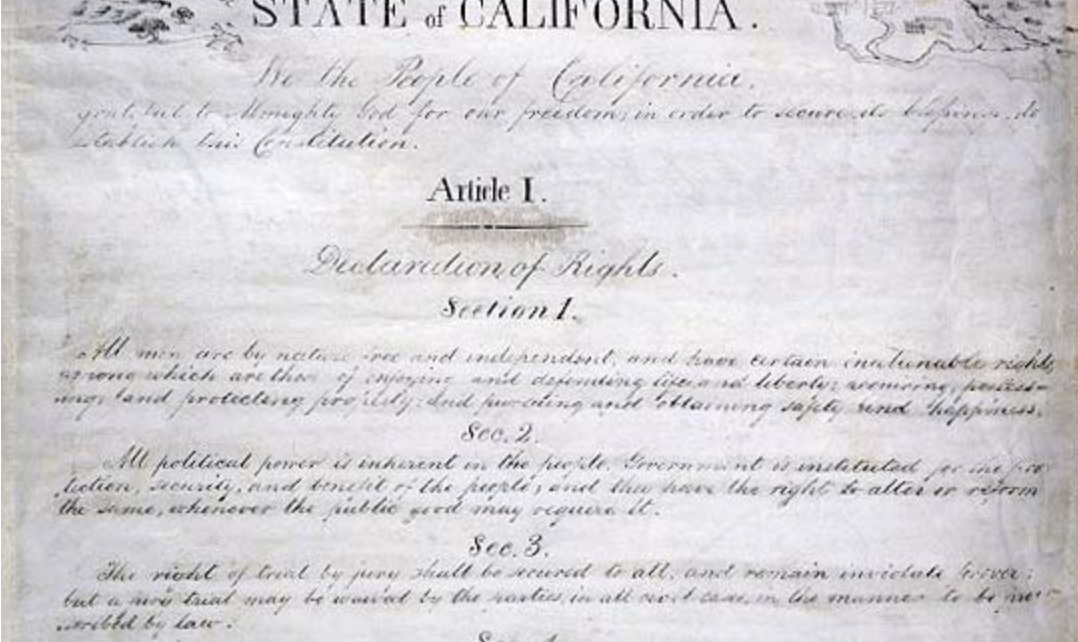
California Constitution. (Photo: www.sos.ca.gov)
Frequently Asked Questions about California Constitution Article XXI
Who is charged with defending the redistricting work?
By Chris Micheli, May 8, 2024 2:30 am
How many sections does Article 21 have? This article contains three sections.
What does Article 21 relate to? It relates to redistricting.
When must redistricting in California take place? Section 1 states that, in the year following the year in which the national census is taken under the direction of Congress at the beginning of each decade, the Citizens Redistricting Commission must adjust the boundary lines of the congressional, State Senatorial, Assembly, and Board of Equalization districts (also known as “redistricting”) in conformance with the standards and process set forth in this article.
Which entity is charged with redistricting in this state? Section 2 specifies that the Citizens Redistricting Commission was created by December 31 in 2010, and in each year ending in the number zero thereafter.
How much the commission conduct its redistricting work? Section 2 provides that the commission must (1) conduct an open and transparent process enabling full public consideration of and comment on the drawing of district lines; (2) draw district lines according to the redistricting criteria specified in this article; and (3) conduct themselves with integrity and fairness.
Who makes up the commission? Section 2 provides that the commission consists of 14 members with specified political party registration and requires each commission member to be a voter who has been continuously registered in California with the same political party or unaffiliated with a political party and who has not changed political party affiliation for five or more years immediately preceding the date of his or her appointment.
What criteria does the commission use in its redistricting? Section 2 requires the commission to establish single-member districts for the Senate, Assembly, Congress, and State Board of Equalization pursuant to a mapping process using the following criteria as set forth in the following order of priority: (1) Districts shall comply with the United States Constitution. Congressional districts shall achieve population equality as nearly as is practicable, and Senatorial, Assembly, and State Board of Equalization districts shall have reasonably equal population with other districts for the same office, except where deviation is required to comply with the federal Voting Rights Act or allowable by law. (2) Districts shall comply with the federal Voting Rights Act (42 U.S.C. Sec. 1971 and following). (3) Districts shall be geographically contiguous. (4) The geographic integrity of any city, county, city and county, local neighborhood, or local community of interest shall be respected in a manner that minimizes their division to the extent possible without violating the requirements of any of the preceding subdivisions. (5) To the extent practicable, and where this does not conflict with the criteria above, districts shall be drawn to encourage geographical compactness such that nearby areas of population are not bypassed for more distant population. (6) To the extent practicable, and where this does not conflict with the criteria above, each Senate district shall be comprised of two whole, complete, and adjacent Assembly districts, and each Board of Equalization district shall be comprised of 10 whole, complete, and adjacent Senate districts.
Who is charged with defending the redistricting work? Section 3 provides that the Redistricting Commission has the sole legal standing to defend any action regarding a certified final map and that it must inform the Legislature if it determines that funds or other resources provided for the operation of the commission are not adequate, in which case the Legislature must provide adequate funding to defend any action regarding a certified map.
Who has jurisdiction to hear any legal challenges to the redistricting? Section 3 provides that the California Supreme Court has original and exclusive jurisdiction in all proceedings in which a certified final map is challenged or is claimed not to have taken timely effect.
Who can challenge the redistricting work? Section 3 allows any registered voter in this state to file a petition for a writ of mandate or writ of prohibition, within 45 days after the commission has certified a final map to the Secretary of State, to bar the Secretary of State from implementing the plan on the grounds that the filed plan violates this Constitution, the United States Constitution, or any federal or state statute.
- Enforcement of Labor Commissioner Judgments - December 6, 2025
- Effect of Emancipation - December 6, 2025
- Harbor Commissions in California - December 5, 2025



